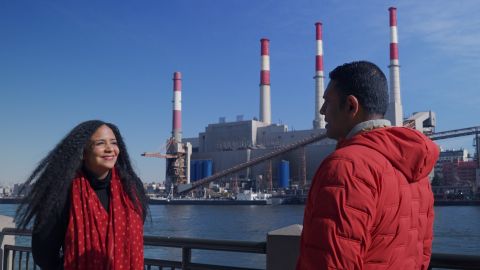Can concrete, a major CO2 emitter, be made greener?
After water, concrete is the most consumed substance on the planet and its production is expected to grow from 4.4 billion tons to 5.5 billion tons by 2050. But its production, which involves cement, comes at a huge environmental cost — accounting for almost eight percent of carbon emissions globally. Mori Rothman of PBS NewsHour Weekend reports on the industry’s attempt to reduce concrete’s carbon footprint with cleaner cement.
TRANSCRIPT:
Hari Sreenivasan:
Next to water, concrete is the most consumed substance on the planet, with more than 4.4 billion tons produced every year, a number that is expected to grow to 5.5 billion by 2050.
But its popularity comes at an environmental cost –the production of concrete, which is made with cement mix, contributes about eight percent of all carbon dioxide emissions worldwide.
NewsHour Weekend’s Mori Rothman reports on how some manufacturers are working to try to reduce the industry’s carbon footprint.
This story is part of our ongoing initiative: Peril and Promise: The Challenge of Climate Change.
Mori Rothman:
About an hour’s drive north of Philadelphia, here in Pennsylvania’s Lehigh Valley, the American cement industry was born.
Cement, which binds together sand and rocks to form concrete, was largely produced in Europe and shipped to the U.S. until the late 1800s. The Lehigh Valley’s rich deposits of limestone, the key ingredient in cement and the adoption of rotary kilns, which are still used today, made U.S. cement manufacturers competitive with European producers.
Jamie Gentoso:
This plant is actually one of the oldest running plants in North America.
Mori Rothman:
Jamie Gentoso is the Global Head of Solutions and Products and the former Head of U.S. Cement for LafargeHolcim, one of the biggest manufacturers of concert in the world. LafargeHolcim owns the Whitehall Cement Plant, which is over 122 years old.
Jamie Gentoso:
You can’t even imagine the modern world without concrete. If you start to think about it, we wouldn’t have airports. We wouldn’t have clean drinking water, bridges, dams, your home, the roads we drive on, it’s literally everywhere.
Mori Rothman:
Globally more than 4.4 billion tons of concrete are produced every year, and that number is expected to go up to 5.5 billion by 2050.
Jamie Gentoso:
Concrete is a product that people don’t think about. When you wake up in the morning. You’re not thinking about concrete, you know, I mean, in the end, it is the second most consumed product in the world next to water.Mori Rothman: But lately, concrete has been under more scrutiny.
That’s because the concrete industry is responsible for about 8% of carbon dioxide emissions worldwide.
Jamie Gentoso:
You have environmentalists and people are really starting to understand the footprint that we have. What we need to do is decouple the volume issue of concrete with, you know, the actual issue.
Mori Rothman:
There’s so much of it being used that inevitably, even if concrete, is a slightly lower footprint, that carbon footprint than a lot of other building materials. You’re just using so much of it that inevitably you’re going to be a large part of global emissions.
Jamie Gentoso:
Yes, but also, to be clear, it’s cement that has the large carbon footprint not concrete.
Mori Rothman:
Cement manufacturing is an energy intensive process. First limestone is collected from a quarry, crushed and mixed with clay and other materials, it’s then heated in a giant kiln at 2,800 degrees fahrenheit.
To reach those high temperatures, coal and other fossil fuels are needed. Additionally, the limestone itself goes through a chemical reaction releasing CO2 as it’s heated up.
The end product, known as “clinker” is ground to a find dust with gypsum to make cement.
Gentoso says LafargeHolcim is reducing CO2 emissions by using alternative fuel like recycled tires and renewable energy sources.
Looking at this larger problem of the emissions that actively we are, we’re trying to shrink. Walk me through like what is possible right now and what’s on the horizon.
Jamie Gentoso:
So net zero is the goal. But obviously that’s where we’re pretty far from that. So we’ve got some short term goals and things that we’re working on for 2030. So we have process emissions, which are just a function of utilizing limestone. Right. We’re heating it up, driving off the CO2, and what we call those are fact of life emissions. If you want to make cement out of limestone you’re going to end up driving off that CO2. And then on the other side is the combustion emissions. So we work on those combustion emissions by trying to find lower CO2 fuels.
Mori Rothman:
Gentoso says to reach net zero LafargeHolcim will need to utilize carbon capture technology. They’re retrofitting a cement plant in Colorado as a pilot project and hope to expand the program to more plants in the US.
Additionally they’re working with Solidia…a company that reduces CO2 emissions with a new cement formula.
Devin Patten is the Director of Technology Deployment at Solidia.Devin Patten: We manufacture Solidia cement at a lower temperature, so less energy requirements in making it and with less limestone, so less burning of calcium carbonate which releases CO2 into the atmosphere. So overall, you have about a 30 percent reduction in the emissions associated with the cement manufacturing.
And then we take CO2 and put it right back into the cement during the curing process, which hardens the concrete. And that’s as much as twenty one percent CO2 by weight of cement.
Mori Rothman:
OK, so if I had a ton of cement then twenty one percent of that ton I could put twenty one percent of a ton of CO2 I could put back into that.
Devin Patten:
Exactly.Mori Rothman: Solidia makes pre-cast concrete- or concrete blocks that are produced at a facility versus ready mix concrete- which can be poured at a construction site and makes up the majority of the concrete market.
Devin Patten:
What’s far down the pipe in development for us right now is the application to get into the ready mix marketplace.
Mori Rothman:
Developing new lower carbon concrete is the first step. Patten says getting widespread adoption in the industry is the next challenge.
Devin Patten:
We’ve had a tremendously positive reception, and this is an industry that is not exactly eager to change, it’s an old industry. But once we go on site, we demonstrate what all these benefits are, the reception has been overwhelmingly positive.
Robert Carroll:
There are some smart ways that we could incentivize large producers of concrete and cement to decarbonize their products.
Mori Rothman:
New York Assemblyman Robert Carroll represents New York’s 44th District. In 2019, he introduced a bill in the New York State Assembly that would give preference to lower carbon concrete in the bidding process for the state funded projects. New Jersey has a similar bill.
Robert Carroll:
There’s a real cost to carbon and because there’s a real cost to carbon, we’re going to incentivize folks who produce concrete with what we call with a lower global warming potential score, which is an international standard that says how much a product impacts our environment. And when a producer provides concrete with a lower global warming potential score, they’ll basically get a five percent bonus that will allow their product to be slightly five percent more expensive, but would still be able to win a bidding process in New York State’s procurement process.
Mori Rothman:
Carroll’s bill passed both chambers in June and is still awaiting Governor Andrew Cuomo’s signature. The bill would set up a task force to examine giving preference to bids from low carbon concrete producers and define state specifications for low carbon concrete.Andrew Cuomo: We have set the most aggressive carbon emissions target in the nation with a mandate of reducing emissions by 40% by 2030 and 80% by 2050.
Mori Rothman:
Two years ago, New York passed the climate leadership act, setting ambitious goals for carbon emissions reductions in the state.Robert Carroll: Climate Leadership Act puts out really big goals of bringing down basically our net emissions to zero by 2040. Well, we’re not going to meet those goals unless we do things like this. You know, there are some boards and panels that they’ve set up to try to figure out ways to incentivize ideas like this. This, you know, sets it in stone.
Mori Rothman:
In New York and New Jersey, they have bills pending that would give preference to projects that use lower carbon concrete. Is that needed?
Jamie Gentoso:
Yeah, I definitely think that’s one of the pieces. We work very closely with our local governments to try to help them understand that “buy clean” is something that’s completely necessary. And, you know, it’s one of the pieces, but it also takes us manufacturers making the change in our- in the business from the upfront.
We are in an industry that’s pretty slow to change. You know, engineers like to specify what they know. I mean, our products hold up buildings, they hold back water, they land planes. We are doing everything that we can to take the steps in the right direction to make our products more eco friendly. We need help from our government. We need help from our customers. We’re working on that from both sides. But the products that we produce provide great value for our industry and for the world.



